Gastric dilatation, aka dog bloat, is a condition where the stomach fills with gas, fluid, or food, causing enough distention to put pressure on surrounding blood vessels and organs. As the swelling increases, the pressure from the stomach cuts off circulation to the stomach and blood flow to the heart. The medical term is gastric dilatation (stomach swelling) and can include volvulus (twisting). We refer to it as GDV.
Dog bloat is an emergency that requires immediate veterinary care. Luckily, 80% of dogs who receive early treatment survive. Knowing the susceptibilities, symptoms, and what you can do to reduce your dog’s risk will improve survival chances in dogs who develop this condition.
What is dog bloat?
In humans, when we feel bloated, we burp, and basically, we’re fine. In dogs, bloating can be a very catastrophic condition that has a rapidly progressing timeline.
Bloat or GDV happens when food, fluid, or air causes the dog’s stomach to expand. As the stomach gets larger, it can prevent the release of stomach contents or gases. As the gases increase, the swelling stomach pushes against the diaphragm, making it harder for your dog to breathe. The increased pressure in the chest cavity and abdomen also restricts blood flow and prevents it from returning to the heart from the abdomen. As bloat progresses, the blood supply to the back half of your dog’s body is disrupted.
Sometimes, the stomach twists, blocking both ends of the stomach and possibly taking the spleen or pancreas with it, preventing anything from getting in or out, and restricting blood flow and oxygen to all of the organs. This loss of blood flow can cause damage and necrosis (death) to the surrounding tissues and organs, causing severe shock and even death in as little as two hours.
What causes dog bloat?
There have been many studies, but no definitive causes found on why dogs develop bloat. However, there are some common determining factors you should know.
What dog breeds are high risk for GVD?
Bloat can happen to any breed at any age. However, there is some research that suggests large and giant breeds with deep, narrow chest cavities are more likely to develop bloat than others.
Large breed and giant breed dogs prone to bloat:
- Great Dane (5-8 times more likely)
- Doberman Pinschers
- Bull Mastiff
- Great Pyrenees
- Weimaraner
- Irish Wolfhound
- Bloodhound
- German Shepherd
- Standard Poodle
- Irish Setter
- Labrador Retriever
- Newfoundland
- Rhodesian Ridgeback
- Akita
- Boxer
- Greater Swiss Mountain Dog
- Old English Sheepdog
- Greyhound
- St. Bernard
Medium dog breeds prone to bloat:
Genetics
Dogs with a close family history of bloat, such as parents, siblings, or offspring, are at greater risk. Your breeder can supply you with your dog’s family history.
Purebred dog breeds are more likely to get bloat than mixed breeds.
Males are twice as likely to develop bloat compared to females. Spaying and neutering have no effect on risk factors.
Age
The age of the dog increases the risk factors. Large breed dogs and giant breed dogs age earlier than smaller breeds, making them at risk as early as 4-8 years of age. While bloat can happen at any age, it is most likely to occur after your dog hits middle age.
Temperament
Many believe that anxious dogs and aggressive dogs can be more at risk for bloat than easy-going dogs. There is no scientific evidence that temperament is a factor, it remains more folklore than fact.
Food and meals
Overeating or drinking too much water can distend the stomach, so a dog can be more at risk for bloat depending on how much and how often they eat. Dogs who eat kibble, or high fat and carbohydrate meals can be at risk. Also, dogs that eat one big meal a day rather than a couple of smaller meals per day can be more at risk.
Generally speaking, dogs who eat quickly can swallow large amounts of air, distending the stomach, risking a bloat condition.
What are the signs of bloat?
Dog bloat is life-threatening and not a wait-and-see situation. If you notice the following symptoms or suspect bloat is occurring, your dog needs to get to the vet ASAP. Don’t wait for a phone call back. Take the dog to the nearest emergency clinic because every minute counts!
- Agitation, whining, pacing
- Shaking, rapid heartbeat
- Rapid shallow breathing, heavy panting
- Excessive drooling
- Attempting to vomit or retching, but it’s unproductive (may throw up foamy drool, but not stomach contents)
- A bloated or distended abdomen that may feel hard. This may be hard to see on overweight dogs.
- Pain, not eating
- Attempts to poop are unproductive
- Hiding or not wanting to be around you
- Shock, pale gums, blue tinge to mucus membranes, rapid weak heart rate
- Collapse
These symptoms may sound scary, but your dog has a good chance of survival if you act quickly.
Treating bloat at the vet
Initial treatment can help stabilize your dog, reduce pain, and determine severity and damage.
Stabilization and diagnostic testing can include:
- IV catheter to administer fluids and medications
- Electrocardiogram (EKG) to look for cardiac arrhythmias and administer meds to stabilize the heart
- Oxygen, if your dog is having trouble breathing.
- X-rays (radiographs) of the abdomen to look for the amount of distention, fluid, gas, and contents of the stomach
- Blood work, including a complete blood count, serum chemistry to check organ function and electrolytes, blood gas analysis
Treatment of bloat
- Stomach relief: Depending on the test results, your vet may insert a tube into your dog’s mouth while they are sedated to decompress the stomach. If that is not possible, a large needle may be inserted into the abdominal wall to allow gasses to escape and the stomach to decompress.
- Emergency surgery: If there is torsion or twisting, your vet will perform surgery. During surgery, the vet will rotate the stomach, and possibly the pancreas and spleen, back to their original positions, and assess any tissue damage. If necrosis is determined, the dead tissue needs to be removed. This could include part of the stomach wall or a spleen removal.
- Preventative gastropexy: This surgical procedure helps prevent the recurrence of bloat in your dog. It involves stapling or attaching the stomach to the abdominal wall so it can’t twist again. If your dog’s breed or history is prone to bloat, many pet parents choose to have the procedure completed during spaying or neutering surgery.
Most dogs will recover from a simple bloat episode quickly, but those with twisting will take longer to recover. Once your dog has recovered, you’ll want to take some preventative measures so this devastating condition can’t happen again. Let’s look at some tips for reducing your dog’s risks.
Reducing the risk of bloat
There’s not a lot of scientific evidence for the exact cause of dog bloat. We know that breed, body type, and family history play an important role in determining susceptibility, but here are some things you can do to reduce the incidence of bloat happening to your dog.
- Provide a healthy diet rich in protein and lower in fats. Add wet dog food to dry food or soak kibble instead of feeding straight, dry kibble.
- Increase the number of meals. Smaller meals throughout the day are less risky than one large meal, which encourages your dog to gorge on food and swallow a lot of air.
- Slow down your dog’s eating speed with a slow feeding bowl, designed with barriers. Your dog eats around the barriers, unable to gulp the food.
- Learn your dog’s lineage and family history. If there is a history of bloat, take precautions and consider preventive gastropexy.
- Don’t heavily exercise your dog before or after a meal. Allow about 30 minutes in between.
Bloat is scary and real risk to our four-legged friends, but we have the ability to proactively protect our dog’s health. Enrolling your dog in a pet insurance plan can help you say ‘yes’ to the best care when the unexpected happens, increasing your precious pooch’s quality of life.
Don’t wait – fetch a free quote today!




